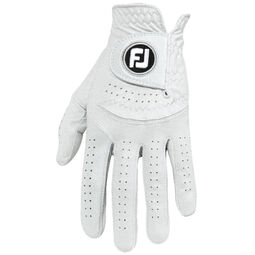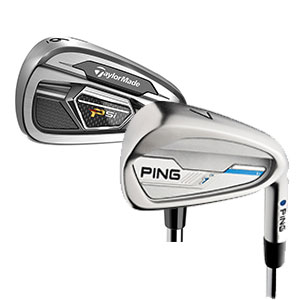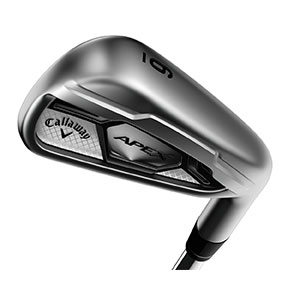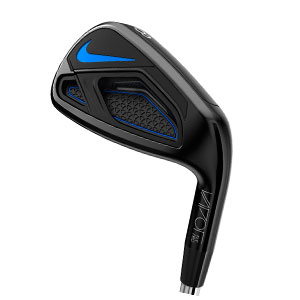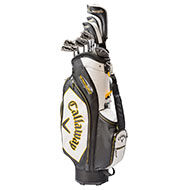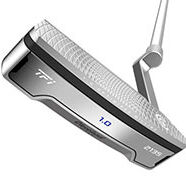Irons Buying Guide
Irons make up the majority of clubs in a players bag, so choosing the right set can make a big difference to their game. And with so many types of irons on the market, all with different specifications, it can difficult to know which is best. This buying guide will help you decide the perfect set of irons, reveal the best brands and offer useful advice on getting everything right in a golf iron.
Super Game-Improvement irons
For golfers who play at a high handicap, super game-improvement irons have the highest offset available which makes them easier to hit for golfers struggling to get the golf ball into the air. Handicaps of 21-28 will find these clubs offering the lowest COG to help with higher golf ball flight and they also come with the largest club head perimeter for a greatly improved forgiveness.
The Callaway Golf Steelhead XR Steel Irons, Callaway Golf Steelhead XR Graphite Irons, Wilson Staff C-200 Irons, TaylorMade M2 Irons and Mizuno Golf JPX900 Irons are just some of the irons that will help golfers with a higher handicap really get to grips with proper feedback and feel when playing a round.
Game-Improvement irons
Game-improvement irons offer plenty of forgiveness and are easy to use. Ideal for mid to high handicap golfers (15-23) with a slight bias towards mid handicappers, game-improvement irons have a low COG that is able to launch golf balls on a steeper angle. Golfers playing at this level in 2015 should try getting to grips with the Mizuno Golf JPX EZ Irons and Titleist AP1 716 Irons as these will absolutely assure precision engineered performances on the golf course.
Intermediate irons
Dual performance and forgiveness is found in the intermediate iron. A mid to low handicap (8-17) is absolutely imperative before putting one of these in your bag as they are less forgiving and will need players will more skill at this level to find them effective. The COG is slightly different from its game-improvement counterparts, utilising a steeper angle and less height carried onto the green. The Callaway Golf Apex Black Irons, Cleveland Golf 588 TT Irons, PING i E1 Irons, Callaway Golf Apex CF16 Irons, TaylorMade PSi Irons, Mizuno Golf MP-25 Irons and Titleist AP2 716 Irons offer the best possible performance for intermediate irons players.
Player’s Irons
Player’s irons are reserved for only the most experienced golfers who have already mastered most aspects of their game and who are now primarily seeking to work on shot shaping and feel. Golfers playing off a handicap of 0-10 (low) will benefit from these irons ten-fold and can also enjoy the lowest, deepest COG available.
Some of the best low handicap and low to mid handicap irons include the PING iBlade Irons Steel 4-PW, Titleist MB 716 Irons, Mizuno Golf MP-5 Irons and TaylorMade PSi Tour Irons.
Choosing club heads
Over-sized cavity back
The over-sized cavity back golf club head is by far the easiest to hit as the head’s surface area is bigger and the vast majority of its weight is stored around the perimeter. The club head is generally more forgiving than its smaller counterparts and off-centre hits fly straighter and farther.
Cavity back
Still very forgiving, a cavity back iron is one in which the back of the club head has been hollowed out to remove weight from behind the centre of the club face. This means more of the club head’s mass is around the perimeter. With the change to the physical appearance and weighting characteristics, the physics of impact between club face and golf ball are also adjusted. The result is a golf iron that’s easier to hit and achieves a wider range of forgiveness for golfers.
Muscle back
Muscle back irons have a full back of the club head as opposed to the hollowed out cavity back iron. Muscle back irons provide golfers with more feedback but also demand the golfer contact the golf ball with the centre of the club face with much greater consistency. Using muscle back irons runs the risk of a greater loss of distance and worse feel on off-centre hits. Muscle backs have higher centre of gravity location, which is able to produce lower trajectory that’s preferred by many golfers. The cavity backs perimeter weighting and lower moment of inertia allows for more forgiveness.
Blade
Blade head irons have more weight positioned behind the middle of the golf club but are very unforgiving and any badly struck shot will be punished. Blades are preferred by many top golfers because it allows them to more easily work the golf ball and feels softer at impact. Blades have a much smaller sweet spot on every shot but the rewards for mastering this golf club head is well worth the practice.
Cast & Forged Club Heads
Forged head
Forged clubs are made by taking a piece of soft steel and beating it into shape. Many golfers claim that forged clubs offer better feel because the steel used in the forging process is softer due to the higher carbon content. Players who use forged clubs get softer feel with shots as well as greater control. The forged head is generally preferred by lower handicap golfers and costs a bit more, but better players will revel in its ability to help them save shots.
Cast head
The vast majority of golfers, probably around 90% - purchase golf clubs made by casting – which involves pouring molten metal into a mould to produce a golf club head. This is a cheaper alternative to forged irons and many more golfers will find it easier to handle than they might with the forged. Many companies will also tell about how soft cast heads are, but always remember that the harder the face of the club, the faster the golf ball will come off of it.
Selecting Shaft
Steel shafts
Steel shafts weigh more than their graphite counterparts and increase consistency at higher speeds. Golfers whose swing speeds is between average to quick will benefit the most from using steel shafts.
Graphite shafts
Female and senior golfers might fare slightly better with a graphite shaft, which weights less and encourages quicker swing speeds for greater distance in each shot, and ideally they are suited to player’s with slower swings.
Shaft ‘flex’
It’s important to consider shaft flex as it refers to the ability of a golf shaft to bend as more force is applied during golf swing. The force is determined by the kind of golf swing you possess; be it fast, slow, jerky or smooth, and there are 5 generally used ratings for shaft flex: Extra stiff, stiff, regular, Senior (or light) and ladies. As the shaft flexes throughout the swing, the position of the golf club head changes. The face of the golf club must be perfectly straight (squared) at impact to get the most out of every shot. There is less chance that you will make contact with the golf ball using a square club face if you have the wrong flex for your swing, so making sure this is correct should take prominence.
View the full range of golf irons available now from American Golf, or view our irons ranges by brand, which includes Callaway, Nike, PING, TaylorMade, Titleist, Mizuno, Cobra, Wilson Staff, Benross, Wilson, Wilson Deep Red, Fazer.

